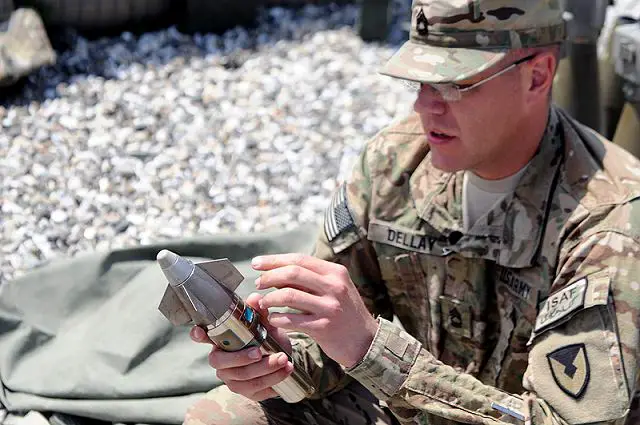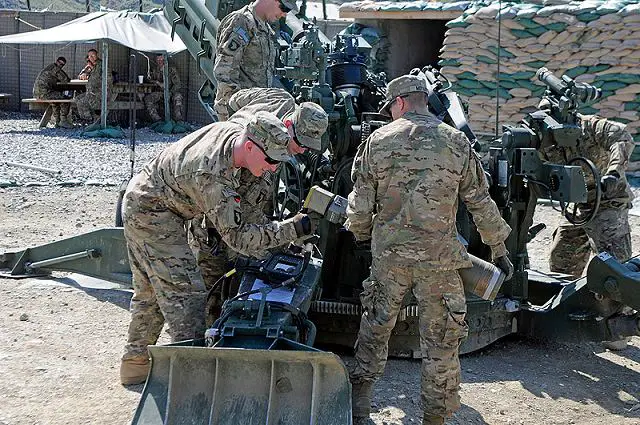New XM1156 PGK provides add-on precision guidance capability for 155mm projectiles 1805134
| a | |||
Defense Industry Technology - XM1156 PGK Precision Guidance Kit |
|||
| Saturday, May 18, 2013, 11:04 AM | |||
| New XM1156 PGK provides add-on precision guidance capability for 155mm projectiles. | |||
Newly-fielded
in Afghanistan, the XM1156 "Precision Guidance Kit" provides
add-on precision guidance capability to the projectiles used in the M109A6
Paladin and M777A2 Lightweight 155mm Howitzer weapons systems. Artillerymen
with Battery's A and B, 2nd Battalion, 15th Field Artillery Regiment recently
became the first unit in Regional Command East to use the Precision Guidance
Kit, or PGK, when they test-fired rounds equipped with the system, April
21. |
|||
 U.S. Army Sgt. 1st Class Brent Dellay, the Precision Guidance Kit Net Noncommissioned Officer in Charge with the Fires Center of Excellence at Fort Sill, OK and native to St. Louis, MO, explains the various parts of a XM1156 PGK Fuse April 29, 2013 at Forward Operating Base Joyce, Kunar Province, Afghanistan. |
|||
| Prior to that first firing, a fielding team from Fort Sill, Okla., provided instruction to the gun line, fire direction center, and fire supporters. The fires teams trained for four days on the PGK. The training included classroom lessons as well as practical exercises. "It was great having our battle buddies from our sister units come to join us with this training," said Staff Sgt. Christian Stephenson, section chief for 1st Section, 1st Platoon, Battery B. "I feel fortunate that my section gets to go through this training and experience this here." The units fired a total of five rounds, all of which landed within five meters of each other and within 25 meters of the target. The effects on target were achieved, and the training proved very successful. "By using the PGK, fire supporters can support the maneuver commander with a more lethal and accurate form of fires," said Sgt. 1st Class Cameron Neal, the battalion fire support noncommissioned officer for 2nd Battalion, 14th Infantry Regiment. "By being more accurate, we can reinforce the maneuver commander's confidence in his fires, allowing us to be relevant in the current fight." The PGK allows field artillerymen to get back into the fight and continue to support and protect ground forces. Additionally, Army documents say the "near-precision" capability the PGK provides "allows operational commanders to engage assigned targets and rapidly achieve desired effects while minimizing collateral damage." |
|||
 U.S. Army Soldiers with Battery A, 2nd Battalion, 320th Field Artillery, 1st Brigade Combat Team, 101st Airborne Division, practice using the Enhanced Portable Inductive Artillery Fuse Setter on a XM1156 Precision Guidance Kit Fuse and the M795 Rocket-Assisted Projectile April 28, 2013 at Forward Operating Base Joyce, Kunar Province, Afghanistan. |
|||
The
PGK is a fuze set on conventional artillery ammunition that allows for
more accurate fires. The system is compatible with two standard artillery
rounds, including the M795 High Explosive and M549/A1 Rocket Assisted
Projectile. It is designed to utilize the basic characteristics of more
advanced "smart" munitions and put them to use with conventional
rounds.
The PGK system uses built-in software, a Global Positioning System receiver, and small "canards," or aerodynamic fins, to provide more accuracy to the round's trajectory. As the round follows its ballistic trajectory, the GPS receiver provides the round's current location and flight pattern. The system compares that data to the target's coordinates. With this "should hit" vs. "will hit" data, the fins rotate to make small corrections to the ballistic trajectory that ultimately guide the projectile on a more accurate path. Spc. Evan Clayton, an advanced field artillery tactical data system operator with 1st Platoon, Battery B, said the difference in accuracy between rounds fired with conventional fuzes and those fired with PGK were noticed immediately. "Our rounds are always on target, that's something we pride ourselves on as a platoon," he said. "But watching the PGK's impact on top of each other, round after round, was definitely impressive. The accuracy was definitely noticeable." The accuracy of area fire weapons is based on "circular error probability," or CEP. This means for any given target a circle can be drawn around it. Based on the characteristics and nature of the weapon system, the round may impact anywhere inside of that circle. The CEP for conventional rounds increases with the range to the target, while the PGK's CEP remains constant at any range. PGK allows for more precise artillery and for fewer civilian casualties on the battlefield. The field artillery has already proven the effectiveness of expensive "smart" munitions. Now they have a cheaper alternative, which still provides the same effective results. The 15th Field Artillery Regiment is not the first unit to receive the PGK. Training on the equipment actually began in Afghanistan in March. The first successful firing during training happened, April 2. Initial fielding of the system will be complete by the end of June. |
|||


























